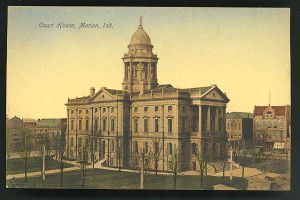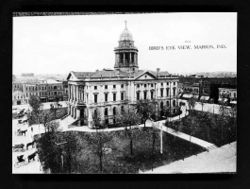Grant County Courthouse
Contents
First Courthouse (1833-1837)
Grant County began constructing its first court house on May 8, 1833. The need for the courthouse came with the ever growing population of Grant County. The house was erected on a mound surrounded by a large forest of trees. It was contracted to James Trimble and was to be built for a sum of $684.00. The court house was to stand two stories high and contain four rooms. The bottom floor contained the actual court room, while the top floor contained three offices. This court house only remained for three years until a new one was necessary to accommodate the growing number of people to the community (Brant and Fuller 287).
Second Courthouse (1837-1880)
The second court house was contracted to Dr. Trask in May of 1837. The contract was then sold to George Webster and was completed for $5000 (Brant and Fuller l84). George W. Webster was born on July 8, 1811. At the age of 16 he took an apprenticeship for three years to learn the carpentry and joiner’s trade. Webster later came to Marion in 1838 where he attained the court house job. Webster constructed a pork house and other large bridges in Marion (Brant and Fuller 70 5-706). While planning for the court house, Webster chose a model of a log cabin to use as a basis for the building. This court house proved purposeful and stood for more than forty years (Brant and Fuller 287).Third Courthouse (1880-present)
The courthouse which now stands in Grant County became necessary in 1880. This year in Grant County was a prosperous one with a big business boom. Many things were happening throughout the city. More than one hundred businesses were constructed in this year with the large growing population (3 March 1880 Marion Chronicle). Some costs for items this year include a subscription to the Marion Chronicle selling for $1.50 and a pair of French Calf high sewed boots selling for $8.00 (29 January 1880 Marion Chronicle). The decision for the need for a new courthouse came at a meeting of the county commissioners on January 8, 1880. A new courthouse became necessary because of a need for a more convenient place to transact business and house the county records.Planning
E. E. Myers of Detroit, Michigan was contracted for the job with a $6,700 salary. His job was to plan and supervise the job which was to be a replica of a standing court house at Elyria, Ohio. He envisioned the court house to resemble a capital, not a fortress, as many court houses in that day were portrayed (Dilts “Grant/Marion”). The job of constructing the court house was awarded to the Hinsdale-Doyle Granite Company on July 17, 1880. These contractors were David B. Sweetser and Philip Matter and the job was to be completed for $100,000 (Frazee 1)
Construction
The first cornerstone of the new courthouse was formally laid on June 1, 1881. The town was decorated in patriotic colors for the inaugural laying of the stone which more than 10,000 people attended. The cost for construction had been rising for some time and the estimates of the final cost vary. According to the Marion Chronicle on August 8, 1880, the cost for completion was to be $133,875.01. The 92 Magnificent Indiana Courthouses Revised Edition stated the cost for the courthouse to be $212,776. The construction for the courthouse was completed in December of 1882 and consisted of the main building with dimensions of 154 feet by 86 feet. The height of the court house was 136 feet and contained a dome with a statue. The Statue of Justice holding a balance in her left hand was placed on the court house and stood 40 feet high. It was obtained for a cost of $475(Frazee 2-3). This statue would remain on the courthouse until a fire in 1943 (Dilts “Grant/Marion”). The head of the statue is now housed in the museum at the Marion Public Library.Grant County’s Meetingplace
Despite the courthouse being resurrected as a place to serve justice, it has also stood as a central meeting place for the townspeople of Marion. The lawn of the courthouse has served as the scenery for Ku Klux Klan rallies, labor speeches, murders, and lynchings. These events have all played important roles in the history of Marion and Grant County.
1904 Visit by Mother Jones
In July of 1904, the Grant County Courthouse lawn welcomed a much heralded speaker, Mother Jones. Mother Jones, also known as Mary Hams, was known as one of the most dangerous women in America. Mary Harris came to Marion as a sixty-five year old lady to speak on behalf of the United Mine Workers (UMW). Her calling to public speaking came when she was educated about coal mining and the dangers involved in the occupation. The speech she gave recalled the recent events of a bloody battle between the Victor Coal Company and the UMW. The battle occurred when the men went on strike and the owners turned to blood to try to prevent the strike. Jones’ speech was warmly welcomed by the many workingmen in the audience and they would forever remember her slogan, “Pray for the dead and fight like hell for the living.” (Munn 15 March 2001).
1930 Lynching
Thursday August 7, 1930, is a date most people in Marion, Indiana will never forget. Three young men, James Cameron, Tom Shipp, and Abe Smith sat in the county jail awaiting trial for murdering a 24-year old white male named Claude Deeter. After being questioned for many hours, they sat in their cell waiting for their initial hearing at the court house. Around nine o’clock that evening, 4,000 people had already gathered on the jail house lawn shouting racial slurs and demanding the keys to the cells which held these criminals. Sheriff Jake Campbell refused to give the keys to the mob, but that did not stop them from proceeding with their plan.
The mob broke into the jail with sledgehammers they had obtained from the Marion Machine Foundry where some of the mobsters were employed. It did not take them long to arrive at the cells where the three boys were being held. Abe Smith was the first to be beaten and killed, followed by Tom Shipp. The two bodies of these young, black teens were dragged to the courthouse lawn where they continued to be beaten. Finally, a rope was tied around their neck and thrown over a maple tree on the courthouse lawn, signaling the lynchings a success. The men continued to stab the victims and even tried to burn their bodies, but their attempts failed. Police arrived from several nearby towns; Muncie, Indianapolis, and Kokomo, but recorded only “peace and good humor.”
With the proud lynchers of Marion crowding around the bodies, many cut clothing from their bodies and stripped bark from the lynching tree. Many photographers also arrived to record this tragic event. Marion photographer, Lawrence Beitler, captured one of the most gruesome photographs ever taken. This photograph, with the Marion Court House lawn in the background, is now used as the generic lynching picture in most books. The bodies were not cut down until 5:45 the next morning when Sheriff Campbell calmed the crowd and cut the bodies from the Maple Tree. The lynchings were over, but the memory would never leave Marion (Madison 5-1 1).
1995 KKK Rally
Almost 65 years later, hatred was again being felt on the courthouse lawn. With men in robes, delivering an anti-black, anti-gay message, the town of Marion was again involved in protest. Many of the people who attended the downtown rally were anti-Klan supporters including James Cameron, the man who survived the lynchings in 1930. The rally was short and not very productive due to the low number of Klan supporters. The police department still issued 160 officers to watch over the event, including a helicopter circling overhead. The people of Marion proved the Klan was unwelcome in Grant County and showed their desire for racial equality and better morals, a great step forward from 1930 (Theobald 26 November 1995).
1996 Murder/Suicide
The year 1996 brought new problems and issues for the Grant County courthouse. After the end of a short divorce hearing, James H. “Skip” Roberts decided to shoot his wife, who had just received a divorce from him. He then shot himself. The murder/suicide occurred on the south steps of the courthouse. After a five minute divorce hearing, Sally Roberts left the courthouse with a male friend. James Roberts also left the courthouse and shot Sally in the head at close range. He immediately turned the gun on himself. Both died instantly and experienced little pain. Although it is not known whether the gun was taken into the hearing or obtained from a car after the hearing, this event called into question the security in place at the courthouse. Security measures have now been expanded at the courthouse (Patterson and Fleming 12 October 1996)
Conclusion
With all of the historical events witnessed by the courthouse, it is obviously one of the most important landmarks in Grant County. Even with the many different buildings that occupied the land, it is still heralded as an important historical landmark in Grant County. With the growth of Marion, came the need for an improved and larger courthouse. Throughout more than 188 years of existence, the county centerpiece has witnessed many events that have shaped the county itself. The courthouse has served as more than a place where justice is served, it has also maintained the status as the center of Marion.
Works Cited
- Brant and Fuller. The History of Grant County. Indiana: Biographical Sketches. Chicago, IL. 1886.
- Dilts, Jon. The 92 Magnificent Indian Courthouse Revised Edition. Indiana University Press. Bloomington, IN. 1991.
- Frazee, Alva T. A Brief History of the Grant County Courthouse. Marion, IN. 12 August
1943.
- Madison, James H. A Lynching in the Heartland: Race and Memory in America. Palgrave. New York, New York. 2001.
- McKown, June R. Marion: A Pictorial History. G. Bradley Publishing Company. 1989.
- Munn, William F. “Mother Jones speaks in Marion” Chronicle Tribune. 15 May 2001.
- Patterson, Steve and Fleming, Lorell. “Shootings at the courthouse.” Chronicle Tribune 12 October 1996.
- Theobald, Bill. “Marion Klan rally mostly noise.” Indianapolis Star. 26 November 1995.
- “The New Courthouse!” Marion Chronicle. 8 April 1880.
Credits
This article was written by Meredith Turner and submitted on January 10, 2002 for Mr. Munn's AP US History class.



